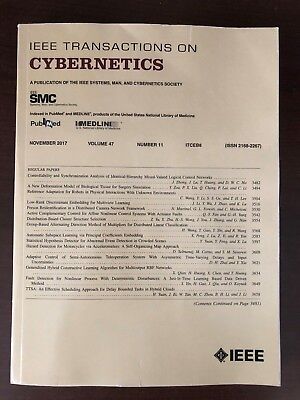多层动态网络准同步误差估计:一种固定延迟脉冲控制方案。
IF 10.5
1区 计算机科学
Q1 AUTOMATION & CONTROL SYSTEMS
引用次数: 0
摘要
本文研究了一类多层动态网络的准同步误差估计问题。所提出的网络模型同时考虑了层间和层内时变耦合结构、网络方向性和层间通信延迟。为了以经济有效的方式实现同步,我们设计了一种新的钉住脉冲控制策略,该策略利用了大规模的脉冲延迟信息和钉住节点的数量。利用迭代算法,建立了一个新的与时滞相关的脉冲微分不等式,该不等式精确地刻画了收敛域,并为脉冲时滞的选择提供了灵活性。然后,导出了保证多层网络在一定误差范围内收敛的准同步准则,并得到了同步误差界的显式解析表达式。最后,将所提准则应用于误差限下多层单连杆机械臂网络的同步,并通过数值算例验证了该方法的有效性。本文章由计算机程序翻译,如有差异,请以英文原文为准。
Error Estimation for Quasi-Synchronization of Multilayer Dynamical Networks: A Pinning Delayed Impulsive Control Scheme.
In this article, we address the error estimation problem of quasi-synchronization for a class of multilayer dynamical networks. The proposed network model simultaneously accounts for interlayer and intralayer time-varying coupling structures, network directionality, and interlayer communication delays. To achieve synchronization in a cost-effective manner, we design a novel pinning impulsive control strategy that leverages large-scale impulse delay information together with the number of pinned nodes. By employing an iterative algorithm, we establish a new delay-dependent impulsive differential inequality, which precisely characterizes the convergence domain and provides flexibility in the choice of impulse delays. Then, some quasi-synchronization criteria are derived to guarantee convergence of multilayer networks within a prescribed error level, and explicit analytical expressions for the synchronization error bounds are obtained. Finally, to demonstrate the practical applicability, the proposed criteria are applied to the synchronization of multilayer single-link robot arm networks under error bounds, with numerical examples validating the effectiveness of the method.
求助全文
通过发布文献求助,成功后即可免费获取论文全文。
去求助
来源期刊

IEEE Transactions on Cybernetics
COMPUTER SCIENCE, ARTIFICIAL INTELLIGENCE-COMPUTER SCIENCE, CYBERNETICS
CiteScore
25.40
自引率
11.00%
发文量
1869
期刊介绍:
The scope of the IEEE Transactions on Cybernetics includes computational approaches to the field of cybernetics. Specifically, the transactions welcomes papers on communication and control across machines or machine, human, and organizations. The scope includes such areas as computational intelligence, computer vision, neural networks, genetic algorithms, machine learning, fuzzy systems, cognitive systems, decision making, and robotics, to the extent that they contribute to the theme of cybernetics or demonstrate an application of cybernetics principles.
 求助内容:
求助内容: 应助结果提醒方式:
应助结果提醒方式:


